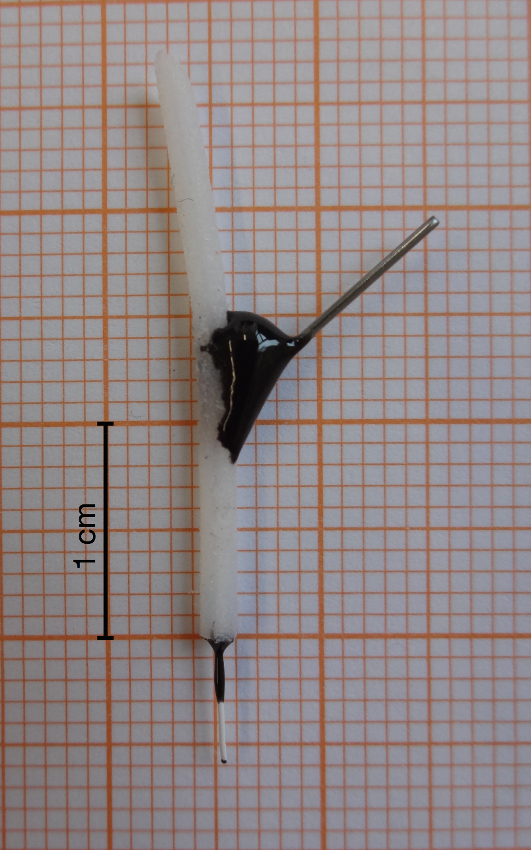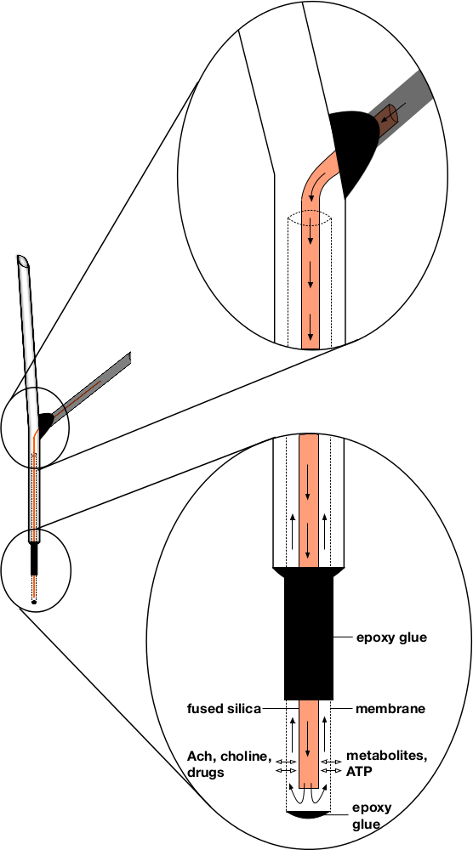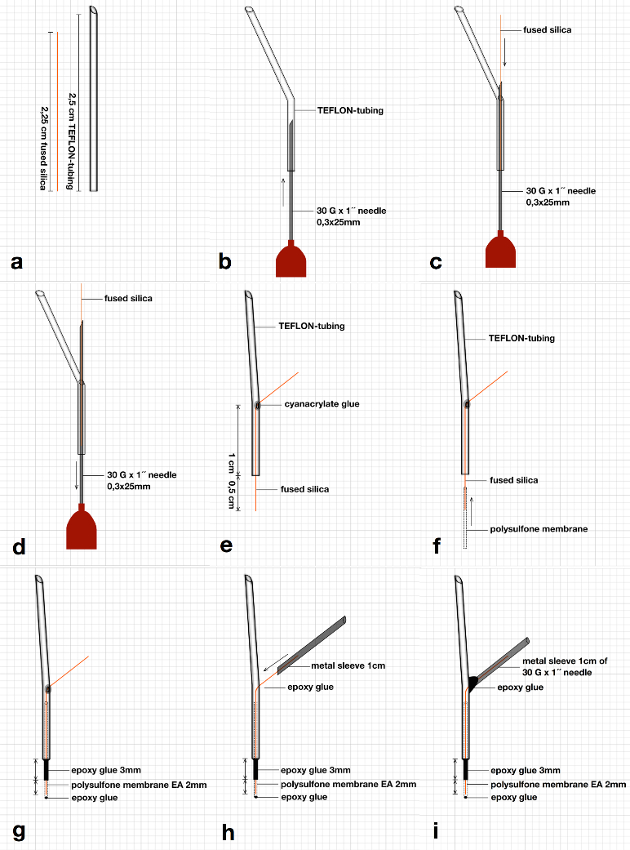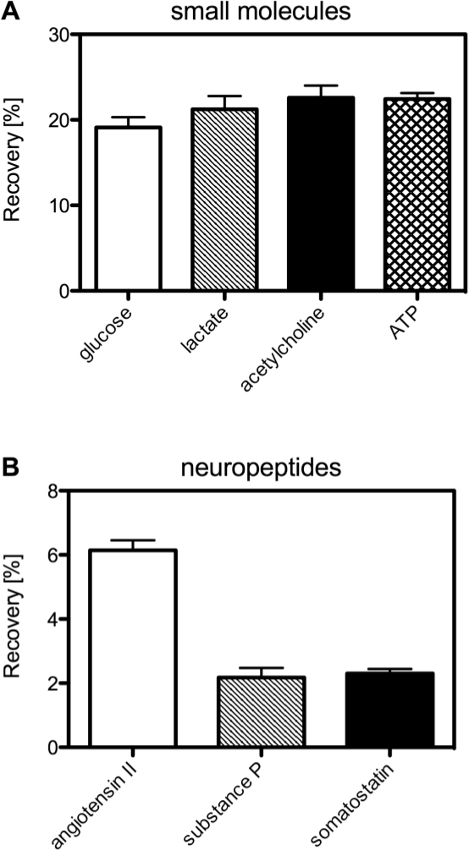概要
Microdialysis is a commonly used technique in neuroscience research. Therefore commercial probes are in great demand.In this work a probe assembly is explained in detail to build a reliable, concentric, custom-made microdialysis probe for less than $10.
Abstract
Microdialysis is a commonly used technique in neuroscience research. Therefore commercial probes are in great demand to monitor physiological, pharmacological and pathological changes in cerebrospinal fluid. Unfortunately, commercial probes are expensive for research groups in public institutions. In this work, a probe assembly is explained in detail to build a reliable, concentric, custom-made microdialysis probe for less than $10. The microdialysis probe consists of a polysulfone membrane with a molecular cut-off of 30 kDa. Probe in vitro recoveries of substances with different molecular weight (in the range of 100-1,600 Da) and different physicochemical properties are compared. The probe yields an in vitro recovery of approximately 20% for the small compounds glucose, lactate, acetylcholine and ATP. In vitro recoveries for neuropeptides with a molecular weight between 1,000-1,600 Da amount to 2-6%. Thus, while the higher molecular weight of the neuropeptides lowered in vitro recovery values, dialysis of compounds in the lower range (up to 500 Da) of molecular weights has no great impact on the in vitro recovery rate. The present method allows utilization of a dialysis membrane with other cut-off value and membrane material. Therefore, this custom-made probe assembly has the advantage of sufficient flexibility to dialyze substances in a broad molecular weight range. Here, we introduce a microdialysis probe with an exchange length of 2 mm, which is applicable for microdialysis in mouse and rat brain regions. However, dimensions of the probe can easily be adapted for larger exchange lengths to be used in larger animals.
Introduction
Microdialysis is a commonly used technique in neuroscience research. During the last 50 years, the minimal-invasive microdialysis technique has been continuously improved to become a well-established method to monitor local concentrations of small molecular weight compounds in the extracellular space. Nearly every interstitial tissue fluid can be investigated in freely moving animals.
Gaddum introduced the push-pull technique in the 1960s. He modified an approach from Feldberg et al. in which tubocurarine was perfused through a cannula ending in the lateral ventricle and collecting the effluent also via a cannula1. Gaddum developed the push-pull technique in which a cannula consisting of two concentric steel needles was implanted in distinct brain areas and perfused by a solution while simultaneously removing the neurotransmitters released from the neurons surrounding the tip2. Unfortunately, tissue damage caused by the cannula around the tip limited the application of this method. As a further advancement of this method, Bito and coworkers introduced a dialysis bag method in which the collected solution was separated from the surrounding tissue by a dialysis membrane. They implanted a dialysis sac into the subcutaneous tissue of dog necks. The content of the dialysis bag is protein-free and could be analyzed many weeks later for ions and amino acids3. The next development was the dialytrode, a primitive microdialysis probe, which originally was described by Delgado in 19724. Finally, Ungerstedt and colleagues improved the design of microdialysis probe so that it was smaller and displaced less tissue5.
A concentric microdialysis probe behaves similarly to a blood capillary. The system is constantly perfused by a solution featuring the ionic composition of the surrounding tissue fluid while lacking the analyte of interest. The dialysis membrane exposed to the external solution or tissue is semi-permeable. It permits passive diffusion of substances into the probe along their concentration gradient6. The permeability is dependent on many variables such as molecular weight, shape, charge and pH of the compound. It is also limited due to properties of the membrane material, pore size of the membrane and flow rate7.
Figures 1 and 2 show a concentric microdialysis probe. The perfusion fluid enters via an inlet tubing into the metal sleeve, which surrounds the fused silica. Inside the metal sleeve, it streams down along the fused silica and leaves it on its tip. In the space between the dialysis membrane and the Polytetrafluoroethylene (PTFE)-tubing (such as Teflon) the perfusion fluid then flows upward. Here, diffusion of substances from the tissue occurs which surround the membrane. The dialysate leaves the probe through the PTFE-tubing, which is connected to outlet tubing and can be collected.
The microdialysis technique has several advantages relative to other in vivo techniques. The probe constitutes a physical barrier with the result that the dialysate contains no enzymes or cells. Therefore, there is no need for purification of the eluate prior to analysis, and no enzymatic degradation of analytes takes place. Oxidative degradation can occur during passage of analytes in the tubing, but this can often be prevented by adding an antioxidant (e.g. ascorbic acid) to the perfusate. Alternatively, oxidative damage to neuropeptides, for instance, was efficiently suppressed by replacing the outlet tubing with a tip to collect the dialysate8. The dialysate can be investigated directly with nearly any kind of analytical method and multiple analytes can be collected simultaneously. This system can be used in awake animals, and nearly all brain regions can be examined. Moreover, infusion of drugs through the probe is possible (retrodialysis). However, there are also limitations of the microdialysis technique. The somewhat low time resolution does not provide real-time information regarding neurotransmitter changes. Because it is an invasive technique, probe implantation causes surgical trauma and anesthesia, which can affect neurotransmitter concentrations, is required during this step7,9,10.
The compound concentration in the dialysate comprises only a small amount of the actual compound concentration in the extracellular fluid. For calculation of the unknown compound concentration in the extracellular fluid, relative in vitro recovery has to be calculated. Determination of individual relative in vitro recoveries for every probe and every compound is necessary before starting the で vivo experiment. For this purpose, the probe is dipped into a solution containing the analyte of interest whereas the perfusion fluid is the same solution lacking the analyte of interest. After determination of compound concentrations in the dialysate, this data has to be referred to their concentration in the surrounding fluid. In vitro recovery determinations of several substances can be implemented simultaneously9.
Many neuroscience research groups use the microdialysis technique to investigate neurotransmitters and metabolites in the extracellular space of distinct brain areas. Thus, commercial probes are in great demand in the neuroscience research environment. A great advantage of commercially available probes is the high functional reliability. The experimental set-up for commercial probes is well established and validated for many well-known neurotransmitters and metabolites. However, whereas the commercially available microdialysis equipment is expensive and has less flexibility in application11, in this work a microdialysis probe assembly is presented in detail, which can be adapted to any application and can be manufactured for less than $10. This custom-made probe is a concentric microdialysis probe tested for investigations in various brain areas8.
In vitro probe recoveries of substances with different molecular weight (range of 100-1,600 Da) and with different physicochemical properties are compared. In vitro recovery determination of glucose, lactate and acetylcholine with a molecular weight less than 200 Da, ATP with a molecular weight of approximately 500 Da and the neuropeptides angiotensin II, substance P and somatostatin with a molecular weight above 1,000 Da is performed.
Protocol
1. Preparing PTFE-tubing
- Shorten PTFE-tubing into 2.5 cm piece. Use a scale paper to estimate physical dimensions. (see Figure 3a)
- Cut one ending at an angle to facilitate connecting of outlet tubing. (see Figure 3a)
- Roughen PTFE-tubing by use of sandpaper to allow adhering of the epoxy glue.
2. Preparing Fused Silica
- Shorten fused silica into 2.25 cm piece. (see Figure 3a)
3. Inserting the Fused Silica into the PTFE-tubing
- Insert a 30 G cannula into the hollow PTFE fiber to pierce it at a distance of 1 cm from the flat end. Bend the PTFE-tubing to simplify the process. (see Figure 3b)
- Insert the fused silica into the PTFE-tubing using the cannula as guidance. (see Figure 3c)
- Gently remove the cannula and secure the fused silica. (see Figure 3d)
- The fused silica is supposed to project 5 mm at the flat end. (see Figure 3e)
- Glue the fused silica in place at the puncture site by cyanoacrylate glue and allow it to harden over night. (see Figure 3e)
4. Preparing Epoxy Glue (Two Component Glue)
- Add 30 parts of yellow hardener to 70 parts of black epoxy glue by help of a fine needle and mix it gently. It is directly ready to use.
5. Applying the Membrane (All Further Steps Must Be Performed Under the Microscope and a Scale Paper is Used to Estimate Physical Dimensions)
- Pull the polysulfone membrane carefully over the fused silica, then pull the membrane into the PTFE-tubing and adjust the membrane to 5.5 mm using a sharp scalpel. (see Figure 3f)
- Set a marking point on the membrane with a fine pen to define the exchange length of 2 mm from the end of the membrane.
- Apply a small amount of epoxy glue to cover the tip of the membrane with the help of a fine needle. (see Figure 3g)
- Close off the joint between dialysis membrane and PTFE fiber by help of the same fine needle used in step 5.3) with the epoxy glue. (see Figure 3g)
- Add enough epoxy glue on the membrane up to the marking point to ensure an exchange length of 2 mm. Allow it to harden over night. (see Figure 3g) Before determination of the exchange length, the membrane is 5.5 mm. After applying the epoxy glue on the membrane, only 2 mm of the membrane is available for diffusion.
6. Applying the Metal Sleeve
- Cut a 25 G needle into 1 cm metal sleeve pieces by help of a bending pliers.
- Pull the 1 cm metal sleeve (25 G) onto the remaining part of the fused silica. The metal sleeve later enables the connection of the inlet tubing with the microdialysis probe. (see Figure 3h)
- Seal joint between metal sleeve and PTFE-tubing with the remaining epoxy glue. Allow it to harden for at least 24 hr. (see Figure 3i)
- Applying hot glue around the bifurcation of the probe for additional fixation and stabilization.
NOTE: The inlet internal volume of the probe is 0.045 µl and the outlet internal volume is 2.5 µl. Therefore, with a flow rate of 1 µl/min, it takes approximately 2.5 min after connecting the inlet tube to start the collection of the dialysate. With the present protocol, the probe assembly procedure yields microdialysis probes that are 95 % reliable.
7. Performance of In Vitro Recovery Experiments
- Dip the probe with a cut-off of 30 kDa and an exchange length of 2 mm into a stock solution composed of aCSF containing 1 mM glucose and 1 mM lactate and, in a separate experiment, into a CSF containing 100 nM ATP and 100 nM acetylcholine.
- Perfuse the probes with aCSF. Set flow rate to 1 µl/min and carry out experiments at room temperature (22 °C). Allow the probes to equilibrate for 1 hr in the stock solution, and collect the samples every 30 min afterwards and store at -80 °C until measurement.
- For the calculation of in vitro recoveries, compare the concentrations of analytes in the dialysates with the known analyte concentrations in the stock solution. Express results as percentages of substance concentration in dialysate vs. stock solution.
Representative Results
The concentric custom-made microdialysis probe consists of a polysulfone membrane with a molecular cut-off of 30 kDa. The probe assembly is illustrated in Figure 3.
It exhibited an in vitro recovery for the small energy metabolites glucose (180.16 Da) and lactate (112.06 Da) of 19.10 ± 1.2% and 21.2 ± 1.6%, respectively. For the positively charged acetylcholine with a molecular weight of 181.66 Da, it showed an in vitro recovery value of 22.6 ± 1.4%. ATP with a molecular weight of 551.62 Da and three negatively charged phosphate residues gave an in vitro recovery to a comparable extent (22.4 ± 0.7%). In vitro recoveries of small molecules are shown in Figure 4A.
Neuropeptides with a molecular weight above 1,000 Da showed lower in vitro recoveries when compared to smaller molecules (<500 Da) (see Figure 4B). Among the tested neuropeptides, angiotensin II (1,046.18 Da) is the smallest peptide with 8 amino acids. It exhibited an in vitro recovery of 6.1 ± 0.3%. The 11 amino acid residue substance P (1,347.63 Da) and the 14 amino acid somatostatin (1,637.88 Da) showed approximately equal in vitro recovery values of 2.2 ± 0.3% and 2.3 ± 0.1%, respectively. In vitro recoveries of our 30 kDa probe are comparable to in vitro recoveries of commercially available microdialysis probes (CMA Microdialysis, Stockholm, Sweden), e.g. lactate 23% and glucose 13% (see application note no. 1)

Figure 1: Photograph of a custom-made probe.

Figure 2: Schematic image of a microdialysis probe (Reprinted from Lietsche et al., 2014, with permission from ELSEVIER).

Figure 3: Schematic image of a probe assembly; step a-i for details see protocol (Reprinted from Lietsche et al., 2014, with permission from ELSEVIER).

Figure 4: Recoveries of small molecules and neuropeptides. (A) In vitro recoveries of glucose, lactate, acetylcholine and ATP. The stock solution contained 1 mM of glucose and lactate and, alternatively, 100 nM ATP and 100 nM acetylcholine for each experimental condition. Results are expressed as percentage of substance concentration in dialysate/stock solution. Values of test substances are means ± SD of n = 22 for glucose, n = 22 for lactate, n = 11 for acetylcholine and n = 13 for ATP. (B) In vitro recoveries of the neuropeptides angiotensin II, substance P and somatostatin. The stock solution contained 100 nM angiotensin II, substance P and somatostatin for each experimental condition. Results are expressed as percentages of substance concentration in dialysate/stock solution. Values of columns are means ± SD of n = 6 for each probe.
Discussion
Figure 3 shows an exemplary probe assembly. Correct inner and outer diameter dimensions have to be closely observed for tubing (OD 1.6 mm; ID 350 µm), fused silica (OD 105 µm; ID 40 µm) and dialysis membrane (OD 245 µm; ID 210 µm). It is also important to keep a space between membrane and fused silica of (105 µm) and between membrane and tubing (105 µm) as well. If the values differ, pressure in the probe can rise and lead to leakage of the membrane.
Here we introduce a microdialysis probe with an exchange length of 2 mm, which is applicable for microdialysis in mouse brain regions. However, dimensions can easily be adapted for larger exchange lengths to be used in larger animals.
Some parts of the assembly can be replaced. For instance, it is not necessary to use PTFE-tubing. Application of polyethylene tubing is also possible with identical outer and inner diameter dimensions. Roughening of the tubing is only necessary when using a PTFE-tubing. A replacement of the dialysis membrane is also possible. For the present probe assembly, a 30 kDa cut-off membrane is used, but any other dialysis membrane can be used with identical dimensions. Therefore, our custom-made probe assembly has the advantage of great flexibility to dialyze substances with a broad molecular weight range; the higher the molecular weight cut-off, the higher the molecular weight of the substance, which can be dialyzed. In vitro recoveries usually increase with the molecular weight cut-off of the dialysis membrane.
To cover the tip of the membrane, epoxy glue is required to close off the joint between dialysis membrane and PTFE-tubing and to determine the exchange length. Applying the cyanoacrylate adhesive is not possible in this step, because it affects the dialysis membrane and leads to leakage. A cyanoacrylate adhesive to glue plastic should be applied for the fixation of fused silica with the tubing in place at the puncture site.
It should be noted that this probe design has not been tested with guide cannulas. Our lab prefers to implant low-diameter probes for acute experiments in which we have 48-72 hr of experimental time before the astrogliosis causes malfunction of the probe. For this type of experiment, a guide cannula does not offer an advantage because guide cannulas are larger and cause more tissue damage. Moreover, even with a guide cannula in place, the probe always has to be inserted into healthy brain tissue, causing acute damage in the area of dialysis. Repeated insertion and removal of the probe through guide cannulas causes repeated damage, a situation which is avoided by one-time, i.e. acute insertion. The blood-brain barrier was shown to be intact few hours after implantation12. Guide cannulas are preferable, however, when serial measurements have to be done over several days or weeks. Finally, volatile anesthetics should be used for probe implantation because injectable anesthetic drugs interfere with subsequent experiments for 1-2 days.
In vitro recoveries for glucose, lactate, acetylcholine and ATP are approximately 20%, i.e. for all tested small molecular weight substances, the in vitro recovery is nearly equal. Evidently, in the lower range (up to 500 Da), the molecular weight has no great impact on the in vitro recovery rate. The molecular weight cut-off of 30 kDa also enables to dialyze neuropeptides. Due to the higher molecular weight of the neuropeptides, the in vitro recovery value is lower. Substance P (1,348 Da) and somatostatin (1,638 Da) can be dialyzed to the same extent with in vitro recovery values of 2-3%. Although both peptides have a mass shift of approximately 300 Da, in vitro recoveries remain the same. Both substance P and somatostatin are positively charged in aqueous solution and may exhibit similar physicochemical properties. Angiotensin II with a molecular weight of 1,046 Da reveals a high in vitro recovery up to 6%, which is three times larger than with the other two neuropeptides. Hence, molecular weights above 500 Da clearly affect the in vitro recovery, even if when substances are charged neutral in aqueous solution. In this case, the in vitro recovery is not affected by the charge of the dialyzed substances. However, with the use of other membrane materials, recoveries of charged compounds can be affected8.
In conclusion, the assembly of a custom-made microdialysis probe is an acceptable alternative to commercial probes. Our self-made probes are sturdy, have high reliability and good reproducibility.
開示
The authors have nothing to disclose.
Acknowledgements
The authors are grateful to G. Barka (SunChrom GmbH, Friedrichsdorf, Germany) for his support and for providing the epoxy glue. Furthermore, the authors acknowledge Fresenius Medical Care (Bad Homburg, Germany) for supplying the Capillary Haemodiafilter FXCorDiax. Funding was obtained from Goethe University of Frankfurt.
Materials
| Epoxy glue | SunChrom GmbH, Fiedrichsdorf, Germany | ||
| Fused silica ID 40 µm OD 105 µm | Ziemer-Chromatographie, Mannheim, Germany | Art. No: 6.040105 | |
| Polysulfone membrane (haemodialysis filter FX Cor Diax 600) | Fresenius Medical Care AG & Co. KGaA, Bad Homburg, Germany | REF: F00001593 | |
| Cyanacrylate glue (Pattex® superglue plastic) | Henkel AG&Co. KGaA, Düsseldorf, Germany | ||
| TEFLON-tubing 1.6 x 0.35 mm | SunChrom® GmbH, Friedberg, Germany | Art. No: 969-195.219 | |
| Scalpel (Feather® Surgical Blade No. 10) | pfm medical ag, cologne, Germany | Art. No: 07310 | |
| Microscope | MEIJI Techno | EMZ-8TR | |
| 30 G x 11" (0.3 x 25 mm) cannula Sterican® Z | B.Braun Melsungen AG, Melsungen, Germany | REF: 9324500 | |
| 25 G x 11/2" (0.5 x 40 mm) cannula 100 Sterican® | B.Braun Melsungen AG, Melsungen, Germany | REF: 9186166 | |
| Fine pen (Stabilo point 88 fine 0.4) | Schwan-STABILO Schwanhäußer GmbH & Co. KG | Art. No: 88/36 | |
| Hot glue (Glue sticks ULTRA Power x 11 mm) | Steinel® GmbH, Herzebrock-Clarholz, Germany | Art. No: 4007841046910 | |
| Sandpaper P60 230 x 280 | Robert Bosch GmbH, Gerlingen-Schillerhöhe, Germany | Catalog Number: 2608605397 |
参考文献
- Feldberg, W., Malcom, J. Experiments on the site of action of tubocurarine when applied via the cerebral ventricles. J Physiol. 149, 58-77 (1959).
- Gaddum, J. H. Push-pull cannulae. J Physiol. 155 (1 P), (1961).
- Bito, L., Davson, H., Levin, E., Murray, M., Snider, N. The concentrations of free amino acids and other electrolytes in cerebrospinal fluid, in vivo dialysate of brain, and blood plasma of the dog. J Neurochem. 13 (11), 1057-1067 (1966).
- Delgado, J. M., Lerma, J., Martín del Río, R., Solís, J. M. Dialytrode technology and local profiles of amino acids in the awake cat brain. J Neurochem. 42 (5), 1218-1228 (1984).
- Ungerstedt, U., Pycock, C. Functional correlates of dopamine neurotransmission. Bull Schweiz Akad Med Wiss. 30 (1-3), 44-55 (1974).
- Ungerstedt, U. Microdialysis–principles and applications for studies in animals and man. J Intern Med. 230 (4), 365-373 (1991).
- Bourne, J. A. Intracerebral microdialys: 30 years as a tool for the neuroscientist. Clin Exp Pharmacol Physiol. 30 (1-2), 16-24 (2003).
- Lietsche, J., Gorka, J., Hardt, S., Karas, M., Klein, J. Self-built microdialysis probes with improved recoveries of ATP and neuropeptides. J Neurosci Methods. 237, 1-8 (2014).
- Chefer, V. I., Thompson, A. C., Zapata, A., Shippenberg, T. S. Overview of Brain Microdialysis. Curr Protoc Neurosci. 7, Unit 7.1 (2009).
- Neurochem, J. Brain Microdialysis. J. Neurochem. 52 (6), 1667-1679 (1989).
- Jolly, D., Vezina, P. In vivo microdialysis in the rat: low cost and low labor construction of a small diameter, removable, concentric-style microdialysis probe system. J Neurosci Methods. 68 (2), 259-267 (1996).
- Sumbria, R., Klein, J., Bickel, U. Acute depression of energy metabolism after microdialysis probe implantation is distinct from ischemia-induced changes in mouse brain. Neurochem Res. 36, 109-116 (2010).

